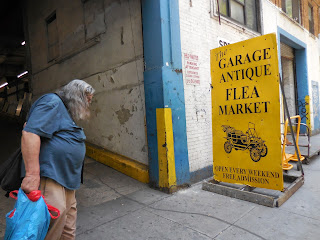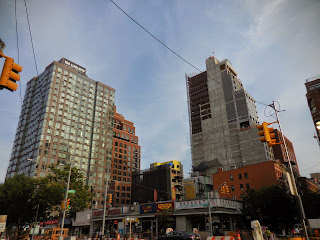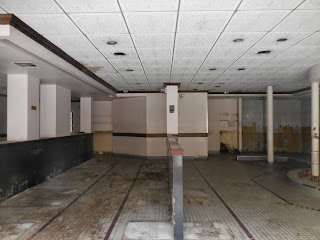On the last weekend of the Chelsea Antiques Garage, before its 1920s-era garage is demolished for a towering luxury hotel, the mood was resigned. This closure had been a long time coming.

Dealers sipped champagne for a farewell toast. Many talked of moving--there's some room at the outdoor flea in a parking lot on 25th, and at the Hell's Kitchen flea further uptown--but it's unclear exactly how so many vendors will fit. Space is limited and being outside is not ideal.
"Paper doesn't do well outdoors," said one vendor, a hawker of vintage nudie photos and other ephemera. "The moisture!"

Most dealers, when asked if they'll move to the other sites, said they'll probably take some time off, travel for the summer up and down the flea market circuit, until the kinks are worked out. Flea market people are gypsies at heart. Whether or not they return to the city is anybody's guess.
This group of flea markets got started in Chelsea in 1976. They were hugely popular with people across the city. Then, in 1995, the City Planning Commission re-zoned 6th Avenue from 24th to 31st Streets, changing it from a manufacturing district to residential and commercial. Immediately, reported the Times, plans were drawn up to put high-rise towers on the flea market sites.
Today, the once low-rise neighborhood has exploded with luxury towers, dull shafts that block the sun and add nothing to the neighborhood, but only take away. At the Garage, many people talked about real estate, the insane prices, and the awful feeling of being pushed to the margins--and then off a cliff. "Where can we go?"

Where can any of us go to get the feeling experienced here?
Drifting through the Garage, you are immersed in the stuff of memory as you shuffle through a bin of records, a box of buttons, a shelf of books. Walking from booth to booth, past glass candy dishes and salt and pepper shakers, everything conjures some association to the past.
You don't know which object will trigger which memory--the process happens so fast--but here come mornings at your grandmother's Florida house (a dish, a spoon), her hand sprinkling sugar onto a half of grapefruit just plucked from the tree.
Turn a corner and here's the album cover that brings back the music of first kisses. Then your big brother's Zippo lighter appears, battered from a tour of duty overseas, and you don't have to hold it to your nose to recall the tart scent of its metal. A cartoon jelly jar takes you back to Kool-Aid. A swizzle stick printed with the name of a long lost cocktail bar cries "Father," while a floral polyester dress brings back Mother, 1978, young and a little bit wild.
When we lose remnants of the past, we lose access to our own memories. Who are we without the antiques to remind us of details lost?

So much is lost.
With the towers have come a different class of people. Unique characters, once plentiful in the city, have diminished in number. For years, the Antiques Garage was their safe haven.
Like the Chicken Lady, a gray-haired woman who walks into the garage squawking like a chicken, loud enough for everyone to hear. People squawk back at her. She calls out, "I'm very sad! I'm very, very, very sad!" She's greeted with kisses and hugs. Asked why she's a chicken, she replies, "I'm the Chicken Lady. That's what they call me. I don't know, maybe it's because I go bawk, bawk, bawk!"

Larry Baumhor takes wonderful photos of the Garage people. There are jewelry designers in bowler hats and antlers, there are punks, fashion critics, and vintage-wear anachronisms.
There are the Idiosyncratic Fashionistas, a pair of women who do their own thing--and do it wonderfully.
And there's the incredible "beyond gender" Zondra Foxx, who has explained, "Zondra was the woman I've always wanted with me. I could never find anyone as weird as I am. I found myself, and I'm the woman I've always wanted."

Said one woman to Larry, in a photo on his page, "They are destroying the individual, the non-conformist. The punk scene is gone. The city is being run by chain stores and is becoming like suburbia. If the Garage vanishes it will affect the non-conformists who are the meat and potatoes of the culture."
What we're left with, after so much has vanished, are objects all too new, meaningless in their freshness, unconnected to any past, containing nothing. We are systematically being erased. First they are taking our memories.
Previously:
Antiques Garage, closing
Antiques Garage close call, 2007


















































